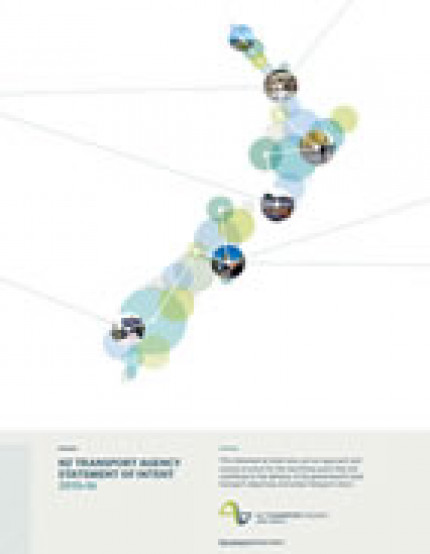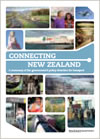This Statement of intent (SoI) sets out an approach and course of action for the next three years that will contribute to the delivery of the government's land transport objectives and wider transport vision. It includes performance measures and what is intended to be measured (and how) and details of what is expected to be accomplished. The document also includes full financial statements. The SoI is a statutory compliance document.
Download the complete report:
NZ Transport Agency Statement of intent 2013–2016 [PDF, 1.5 MB]

| Previous page | Table of contents | Next page |
The government transport sector is seeking an effective, efficient, safe, responsible and resilient transport system that supports a thriving New Zealand.
New Zealand will thrive when its transport system is effective in moving people and freight where they need to go in a timely manner.
An efficient transport system will deliver the right infrastructure and services to the right level at the best cost and show resilience in how it meets future transport needs and endures shocks. And in order to help New Zealand thrive, its transport system has to be responsible in how it reduces the harm from transport such as road trauma and environmental impact.
The NZ Transport Agency's (NZTA) purpose is to deliver transport solutions for a thriving New Zealand on behalf of the government. We are specifically responsible for the following four functions:
Beyond these four functions our broader aim is to make sure that people have a seamless experience across New Zealand’s land transport system, including local roads, public transport, rail and other parts of the network. We therefore invest and operate with a ‘whole of system’ outlook.
For the next three years, the government’s immediate priorities for transport are investment in infrastructure, better quality regulation, a safer transport system and opening markets. The Minister of Transport’s Letter of Expectations to the NZTA sets out these priorities, and requires the NZTA to continue focusing on delivering value for money in all we invest in and do, applying a strong customer focus and working towards a more resilient transport sector.
This Statement of intent gives effect to the government’s direction for transport and addresses the Minister of Transport’s Letter of Expectations.
The Land Transport Management Act 2003 (LTMA) establishes the NZTA, and provides the legal framework for managing and funding land transport activities and provides for a Government Policy Statement on Land Transport Funding (GPS).
Under this legislation we have the following responsibilities:
Also of key importance is the Land Transport Act 1998, which promotes safe road user behaviour and vehicle safety, provides for a system of rules governing road user behaviour, and the licensing of drivers and technical aspects of land transport.
Other relevant legislation includes the Railways Act 2005, the Government Roading Powers Act 1989 and the Road User Charges Act 2012.
Land transport rules are a form of delegated legislation similar to regulations. The NZTA produces rules for the Minister of Transport under an agreement made with the Chief Executive of the Ministry of Transport. Land transport rules have a significant influence on access of people and vehicles to road and rail networks, and guide the conduct or use of the networks.
The Land Transport Management Act 2003 outlines that the NZTA’s statutorily independent functions are to:

Connecting New Zealand(external link) is a summary of the government’s policy direction for transport. The document notes that the government is seeking a transport system that supports the growth of our country’s economy, in order to deliver greater prosperity, security and opportunities for all New Zealanders. New Zealand is a trading nation, but geographically we are further away from the economic centres of the world than any other developed country. Therefore to be internationally competitive, we need to improve the efficiency of our transport networks by focusing on three key areas: economic growth and productivity, value for money and road safety.

The Government Policy Statement on Land Transport Funding (GPS)(external link) sets out the government’s priorities for expenditure from the National Land Transport Fund over the next 10 years. It sets out how funding is allocated between activities such as road safety policing, state highways, local roads and public transport. The GPS directly guides the investment that the NZTA makes in the land transport system on behalf of the government. How the GPS frames the NZTA’s investment function is set out inrelation to the ‘Maximising return for New Zealand’ section of the Statement of intent.

Safer Journeys(external link) is the government's strategy to guide improvements in road safety over the period 2010 to 2020. The strategy's vision is a safe road system increasingly free of death and serious injury. This is underpinned by the world leading Safe System approach to reducing death and serious injuries from road crashes. The priority areas are those where significant change is needed to make an improvement, and where improvements can help to reduce a large number of road deaths and serious injuries. Safe speeds, impaired drivers and vehicle safety are all 2013–15 priority focus areas. Progress will continue to be made in other key areas such as roads and roadsides, young drivers, motorcyclists, distracted and fatigued drivers, high-risk drivers, walking and cycling, restraints and older drivers.

The purpose of the National Infrastructure Plan(external link) is to improve investment certainty for businesses by increasing confidence in current and future infrastructure provision. The government's 20-year vision for New Zealand's infrastructure is that by 2030, New Zealand's infrastructure is resilient, coordinated, and contributes to economic growth and increased quality of life. The National Infrastructure Plan outlines a three-year programme of work to progress this vision.

New Zealand Energy Strategy(external link) sets the strategic direction for the energy sector and the role energy will play in the New Zealand economy. The government’s goal is for New Zealand to make the most of its abundant energy potential through the environmentally responsible development and efficient use of the country’s diverse energy resources. The New Zealand Energy Strategy 2011– 2021 sets out four priority areas: diverse resource development; environmental responsibility; efficient use of energy; and secure and affordable energy. The Energy Efficiency and Conservation Strategy(external link) (NZEECS), a companion strategy, is specifically focused on the promotion of energy efficiency, energy conservation and renewable energy. The NZEECS sets out six objectives for six sectors, which will contribute to the overall New Zealand Energy Strategy 2011–2021 goal. The objective for transport is to create a more energy efficient transport system, with a greater diversity of fuels and alternative energy technologies.
| Previous page | Table of contents | Next page |